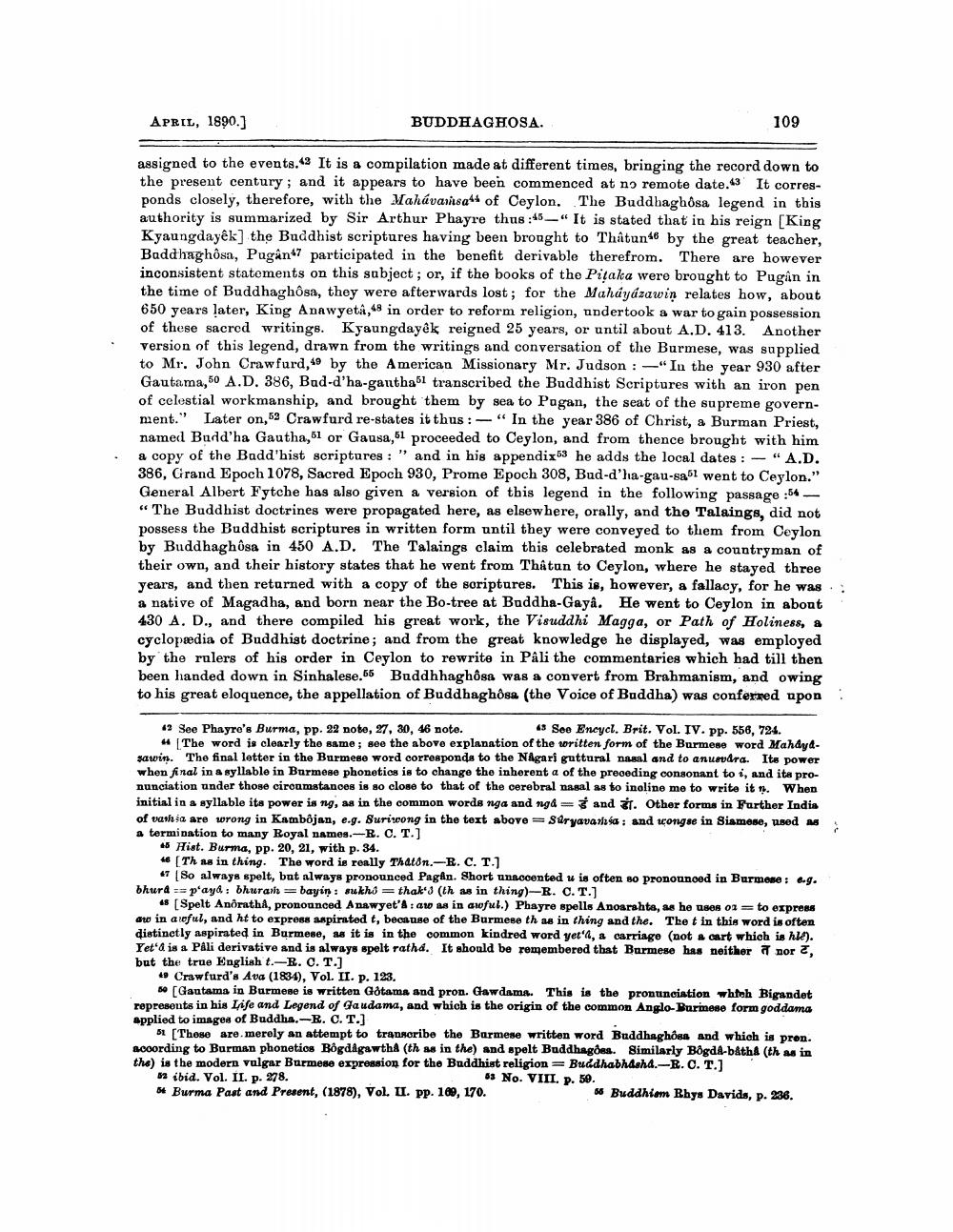________________
APRIL, 1890.)
BUDDHAGHOSA.
109
assigned to the events. It is a compilation made at different times, bringing the record down to the present century; and it appears to have been commenced at no remote date. It corresponds closely, therefore, with the Mahávansas of Ceylon. The Buddhaghôsa legend in this authority is summarized by Sir Arthur Phayre thus:45_" It is stated that in his reign [King Kyaungdayêk] the Buddhist scriptures having been brought to Thâtun46 by the great teacher, Baddhaghosa, Pugan participated in the benefit derivable therefrom. There are however inconsistent statements on this subject; or, if the books of the Pitaka were brought to Pugân in the time of Buddhaghosa, they were afterwards lost; for the Maháyázawin relates how, about 650 years later, King Anawyetâ, 48 in order to reform religion, undertook a war to gain possession of these sacred writings. Kyaungdayêk reigned 25 years, or until about A.D. 413. Another version of this legend, drawn from the writings and conversation of the Burmese, was supplied to Mr. John Crawford, 49 by the American Missionary Mr. Judson : -"In the year 930 after Gautama,50 A.D. 386, Bad-d'ha-gantha51 transcribed the Buddhist Scriptures with an iron pen of celestial workmanship, and brought them by sea to Pagan, the seat of the supreme government." Later on, 52 Crawfurd re-states it thus:-" In the year 386 of Christ, a Burman Priest, named Buddha Gautha, 61 or Gausa, 61 proceeded to Ceylon, and from thence brought with him a copy of the Badd'hist scriptures : " and in his appendix53 he adds the local dates : - "A.D. 386, Grand Epoch 1078, Sacred Epoch 930, Prome Epoch 308, Bud-d'ha-gau-sa61 went to Ceylon." General Albert Fytche has also given a version of this legend in the following passage :54 - “The Buddhist doctrines were propagated here, as elsewhere, orally, and the Talaings, did not possess the Buddhist scriptures in written form until they were conveyed to them from Ceylon by Buddhaghosa in 450 A.D. The Talaings claim this celebrated monk as a countryman of their own, and their history states that he went from Thâtun to Ceylon, where he stayed three years, and then returned with a copy of the soriptures. This is, however, a fallacy, for he was a native of Magadha, and born near the Bo-tree at Buddha-Gaya. He went to Ceylon in about 430 A. D., and there compiled his great work, the Visuddhi Magga, or Path of Holiness, a cyclopædia of Buddhist doctrine; and from the great knowledge he displayed, was employed by the rulers of his order in Ceylon to rewrite in Pali the commentaries which had till then been handed down in Sinhalese.65 Buddhhaghôsa was a convert from Brahmanism, and owing to his great eloquence, the appellation of Buddhaghðsa (the Voice of Buddha) was conferred upon
12 See Phayro's Burma, pp. 22 noto, 27, 30, 46 note.
* Soo Encycl. Brit. Vol. IV. pp. 556,724. The word is clearly the same; see the above explanation of the woritten form of the Burmese word Mahdydsawin. The final letter in the Burmese word corresponds to the NAgari guttural nasal and to an undra. Its power when final in a nyllable in Burmese phonetics is to change the inherent a of the prooeding consonant to, and ita pronunciation under those ciroumstances is so close to that of the cerebral nasal as to inoline me to write it. When initial in a syllable ita power is ng, as in the common words nga and ngd and ar. Other forma in Further India of vash ja are wrong in Kambojan, e.g. Surisong in the text above = Saryavansa: and wongse in Siamese, used as a termination to many Royal names.-B. C. T.] 15 Hist. Burma, pp. 20, 21, with p. 34.
[Th as in thing. The word is really Thaton.-R. C. T.)
7 [So always spelt, but always pronounced Pagan. Short unaccented u is often so pronounced in Burmese : e.g. bhurd == p'aya: bhurash bayin: sukhi thak3 (th as in thing)-R. C.T.)
45 [Spelt AnõrathA, pronounced Anawyet'A: ar as in croful.) Phayre spells Anoarahta, as he uses 01 = to express ato in awful, and ht to express aspirated t, because of the Burmese th as in thing and the. The t in this word is often distinctly aspirated in Burmese, as it is in the common kindred word yet'l, a carriage (not a cart which is hie). Yet'& is a Páli derivative and is always spelt ratha. It should be remembered that Burmese has neither nor , but the true English t.-R.C.T.]
49 Crawfurd's Ava (1834), Vol. II. p. 123.
so (Gautama in Burmese is written Götams and pron. Gawdams. This is the pronunciation whtoh Bigandet represents in his Life and Legend of Gaudama, and which is the origin of the common Anglo-Burmese form goddama applied to images of Buddha.-R.C.T.)
51 [These are merely an attempt to transcribe the Burmese written word Buddhaghoss and which is pron. nooording to Burman phonetics Bogdagawtha (th as in the) and spelt Buddhages. Similarly BôgdA-bAth (th as in the) is the modern vulgar Burmese expression for the Buddhist religion = Buddhabhasha.-R.O.T.) ibid. Vol. II. p. 278.
63 No. VIII. p. 50. 54 Burma Past and Present, (1878), Vol. II. pp. 100, 170.
Buddhism Rhys Davids, p. 236.




